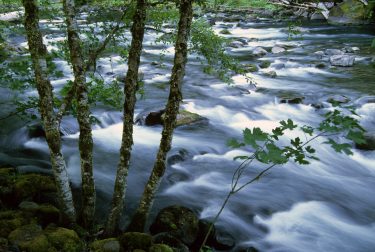 Mushrooms have a long-standing history as a culturally and nutritionally significant food source, yet we still have much to learn about our fungal friends. Enter the wondrous world of mushrooms: some toxic, some colorful; some cap-tipped, some mimicking a wave in the ocean. Regardless of how much research has been done on fungi, we have only scratched the surface, with only four percent of fungi species characterized.
Mushrooms have a long-standing history as a culturally and nutritionally significant food source, yet we still have much to learn about our fungal friends. Enter the wondrous world of mushrooms: some toxic, some colorful; some cap-tipped, some mimicking a wave in the ocean. Regardless of how much research has been done on fungi, we have only scratched the surface, with only four percent of fungi species characterized.
School of Aquatic and Fishery Sciences graduate student Anne Polyakov spent a summer with the UW Alaska Salmon Program studying ecosystems along three salmon streams, hoping to use the data collected to track how nutrients flow into all parts of the system — into the soil, plants and the role that fungi play in this intricate process.
Mushrooms made from salmon
Dead salmon potentially play a large role in nutrient cycling, dissolving and flowing through every component of the ecosystem surrounding salmon streams in a vast, multi-directional web.
Fungi are one of the primary decomposers of salmon carcasses, taking up the nutrients through their hyphae (the long, thin white strands that make up the main bulk of the fungi) and either consuming them for their own metabolic needs or passing some along to plant partners that need them for growth or maintenance. These nutrients are then used to produce structures such as leaves or mushrooms, which can be further cycled through the ecosystem when they’re eaten by animals.
“Fungi are typically left out of the equation when scientists track and model salmon nutrient flow through the salmon stream forests,” said Polyakov. “But these fungi are very important, as they connect the soil below to the plants above, and also form networks that allow for possible redistribution of nutrients to other plants and fungi.”
Tracing the salmon signature
But how do researchers follow these nutrients from the streams to the leaves of nearby trees? It turns out that salmon have a special chemical signature in their tissues that can be used to trace nitrogen that originates in their bodies. This signature arises due to the fact that salmon spend much of their adult life in the ocean, where the nitrogen signature looks very different from nitrogen that originates in terrestrial systems. Salmon “pick up” this signal during their time at sea, making their nutrients stand out when they return to freshwater streams and, eventually, make their way onto land.
Although the nutrient tracing from salmon to soil and vegetation has been studied, little to nothing is known about the role of fungi in this process. This is where Polyakov’s research comes in. Alaskan mushrooms are super under characterized, so by collecting 250 mushrooms, in addition to soil and leaf samples, she hopes to sequence these mushrooms to add to the fungal species database, filling in the gaps of which fungal groups are located in these regions of Alaska, and incorporating fungi in the salmon nutrient tracing process alongside soils and plants.
It’s very likely that these salmon nutrients are vital to the ecosystems that surround their home streams. But as some salmon populations decline, it’s unclear how those ecosystems will manage. “There are a ton of places where salmon aren’t coming back or the salmon runs are dwindling,” Polyakov said. “A big question in the field is, what’s going to happen to the fungal systems that have adapted to receiving salmon nutrients for millenia if salmon numbers continue to decline?” Polyakov hopes that this research might one day help us better answer that question.
Another concern surrounding diminishing salmon runs is the possibility that the fungi that have evolved to feed off salmon carcasses may diminish entirely. Because so few fungal species have been discovered so far, we may not even know what these species are, or their role in the ecosystem, before they disappear completely.
Although there have been extensive studies on how salmon-derived nutrients affect vegetation and soils, the effects of these nutrients on fungi are mostly unknown. This is important because fungi are what connect the plants to the soil and are thus an essential, and often overlooked, component of this system. When we examine how fungi interact with salmon-derived nutrients, we can better understand and model the presence and ecological significance of salmon nutrient inputs to terrestrial systems by considering and integrating all components of this system — soil, plants, and fungi, in this interconnected web.
Story by Joy Chu

